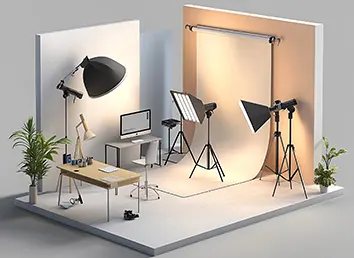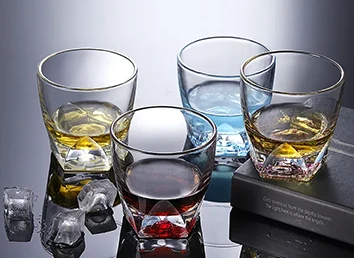Shooting glass and transparent body of the three ways of expression
Author: Jeery Zhang
Date Created: 2023-09-13 16:02
These products have high-grade glass, crystal products, low-grade plexiglass, and transparent plastic utensils. These subjects focus on shooting, one is to show the transparency of the texture of the delicate and transparent body; the second is to portray them or beautiful and beautiful modeling, or ancient Austrian simplicity of the pattern.

Light propagation in the transparent body, only a small amount of scattering, which makes them in the normal angle of observation will be presented as transparent, and not easy to clear. The key to purely characterizing the textural expression of a transparent body. The smaller the angle of incidence of the projected light, the more light is reflected, and its reflection produces a flare; light changes direction and refracts as it penetrates different transparent media; and when a curved surface is illuminated with tangential light, the edges are opaque and appear as black or dark contours.
According to the following items, the texture of the glass performance needs to be different from other types of lighting treatment. Lighting is generally simple, the main light, the light of the strong, weak, hard, and soft to determine the subject of the contrast between light and dark, the clarity of the contour lines, patterns of alternating light and dark, flare of the visible and hidden.
Regardless of the shape of the glass products, the smooth surface of the surrounding environment, especially on the light reflection is very dark. So when shooting the subject and the environment must be isolated. The studio is best to darken all, any light leakage gap may be formed on the surface of the glass body flare.
Glass body in the performance, there are usually dark lines, two lines, and the main body of three kinds of performance.
DARK LINES
The dark line performance of transparent glass body mainly utilizes the refraction of light in different media to form.
The important feature of the dark line performance is to portray the outline of the glassware as dark lines. The prerequisite for such lighting is that the background must be brightly colored. Lighting, the subject and the background to leave a sufficient distance between, in addition to the main light and almost always do not make direct illumination.
The background is mostly used with a continuous background, in order to eliminate vertical and horizontal facial pleasant intersection of the line. Background material can be divided into translucent and opaque two kinds. The former more from behind the background with floodlights or spotlights, the background will be scattered light and then irradiate the subject. It should be noted that this direct light should never be directed to the subject. Both of these lighting methods can form dark lines around the edges of the subject. The thickness of the lines depends on the wall thickness of the subject.

Varying the area and intensity of the reflection controls the contrast of the image because it depends on the diameter of the light field relative to the surface of the subject. The smaller and stronger the light field, the greater the contrast. Sometimes, in order to avoid the horizontal part of the background is difficult to light, translucent background or pedestal can be used, from the bottom of the appropriate lighting, but should be careful that this light must not be so strong that it interferes with the performance of the black lines.

In the use of basic lighting, if you feel the need to fill the front of the subject, you can use a reflector or diffused soft light.
When you feel that the subject on both sides of the outline is not dark enough, the remedy is to use black paper set on both sides of the vertical part of the background, used to reflect the black tones on the edge of the vessel, regulating and strengthening the level. If you feel inconvenient to set the black paper strip, you can roll the black paper into a cylinder shape, you can move back and forth freely.
Black line performance, sometimes part of the edge of the vessel may appear bright line, so that it is not easy to jump out from the bright background, or that part of the bright line will be merged with the background of the dark and light can not be distinguished. When this happens, you can use ink to carefully draw a thin line on the edge, which can isolate the subject from the background. Just to do fine work, to fake, do not reveal the cracks.
Dark line performance has a sense of volume, sense of weight, and have a high-key effect, the contrast between light and dark is mainly determined by the brightness of the lighting.
BRIGHT LINE PERFORMANCE
Two lines is the use of light on the surface of the transparent medium to express the phenomenon of reflection. Bright lines of glass body performance undoubtedly the background must be dark, and even black, in order to show the bright lines of the vessel.
Bright lines of light method has the following kinds:
Above the side of the glassware with fog lamps, soft masks or other diffusion of light illumination of the subject, can cause the two sides of the glassware and the top surface of the outer contour of the bright lines. When the area of the light source is large, the bright lines can be molded symmetrically on both sides for small subjects. If the subject is slightly larger, or to achieve asymmetrical effects, two diffused light sources can be used to cross the light from the back side of the glassware. The contrast and thickness of the bright line depends on the strength and position of the light source. In a special need, only from the back of the glassware side of the light will also produce interesting results, such as the other side of the edge and the background fusion, you can set up a reflector on this side of the appropriate position to fill the light, will also get a bright line.

Another method is in front of a deep dark background, behind the two sides of the glassware, each set a piece of white reflective, and then directional direct light source, such as a spotlight or a direct light source with a honeycomb light guide, such as a spotlight or a floodlight with a honeycomb light guide to irradiate the reflective plate, the use of reflective plate reflective diffuse light to illuminate the two sides of the subject, the formation of a bright line. It should be noted that the reflector should be outside the lens angle of view. The light thrown into the reflector to limit the light, do not interfere with the performance of the glassware.
Both types of lighting are aimed at showing the bright lines of the outer contours of the glassware. From the point of view of the lens, it will be found that in addition to the bright lines, most of the space area of the vessel is presented in the background of the dark tone. In order to emphasize the subject's glassy subject surface, that is, generally the face closest to the camera, you can add one or two stripes of flare in its appropriate parts. Method is to form a flare on the opposite side of the appropriate location to place one or two small and bright reflective material, the use of diffuse light from the main light source so that it is selected to be observed from the camera focusing screen, repeatedly moving until the intended position after fixing. Another method is that you can use white paper to hit the floodlight to cover, and then close the shade baffle, only open to a certain width, and adjust the height and direction, so that it reflects on the glassware, you can form the former and the said decorative light. The light position should be carefully moved away from the optical axis of the lens. Although this decorative light can enhance the depth of perspective and modeling, but the engraved glass should be careful not to form a flare in the texture of the texture of the performance of the texture.

Bright line representations must isolate the input of each light source to the background, or you may not get deep dark background tones.
With a starburst mirror to the glass body of the extremely delicate highlights processed into a cross-shaped, meter-shaped light, can add some interest, but the light should be small rather than large.
In the deep dark even the bottom of the background of the level of a piece of flat glass, and then the subject placed on it, you can get the reflection.
Bright lines show a little bit in front of the dark background, the subject of the bright outline is very striking, in the colored background, the bright lines of glassware will not change the color of the original color. However, the bright line is not suitable for polyhedral representation, the reason is that it may cause one of the faces to form a very strong flare and lose details.
VERNACULAR REPRESENTATION
This lighting method is not to seek the effect of striking lines, but to emphasize the performance of the glassware itself. Lighting special requirements are, such as the background is not translucent body, the main light from the background behind the transmission, with scattered light illumination of the subject; background if the light-colored opaque objects, the transmitted light to the background, and then use the background of the reflected light illumination of the subject, but at this time must be in the head of the lamp with a beehive light guide or shielding baffle, do not make the light thrown on the subject.

In front of a brighter background, the peripheral outline of the glassware will be darker lines. Usually no fill light is needed on the front; light transmitted from the background will illuminate the subject.
The body performance can make a big difference in the background. Such as the transmission of light to think of the background to block the background can be treated as a gradient from top to bottom, or bottom to top shadow. You can also focus on the background to cast light, control the light field, resulting in the formation of key performance in the area around the subject, resulting in the formation of key performance in the area around the subject. In addition, the use of a variety of rhythmic pattern of flat glass as a background, seeking to change, rhythmic and interesting performance, and the use of floodlights from the back of the light casting, the use of wide light, narrow light, high light, low light and special round light to compare the different effects. You can also add color film in front of the light, cast partial or all, one color or two colors of light to make the subject brilliant.

Regardless of which lighting method of transparent body lighting, the principle is as far as possible not to use direct light or the use of the lowest amount of light source. To emphasize the impression of the environment, or contrast, or harmony, or gradation, but there should be a dominant tone, contrast will be alive. The ideal light effect is evaluated as the one that enables the glass body to express its stylistic personality in the most concise and eye-catching way. This, in turn, relies heavily on the use of strongly contrasting rim light to outline the contours, and narrow light decorative light to enhance the texture.
Shooting transparent body, must be thoroughly cleaned beforehand, without leaving any dust, smudges, fingerprints, otherwise they will be clearly and obviously exposed.
The focal length of the lens should be long enough to make it easy to spread the light, but also to avoid distortion. If you have to shoot up and down, use the front and rear seat of the camera to lift and lower the camera to eliminate the convergence of vertical lines.











